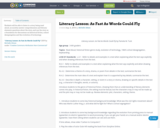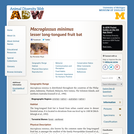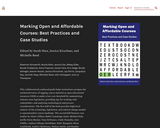
Nebraska FCS Classes: Intro to Design
- Subject:
- Career and Technical Education
- Education
- Material Type:
- Activity/Lab
- Lesson
- Lesson Plan
- Date Added:
- 07/17/2019

Nebraska FCS Classes: Intro to Design

This website was designed to replace a traditional textbook in a 100-level General Science/Earth Science class. Open Educational Resources are listed to for each subject and accompanying homework assignments are based on assigned readings. Learning Objectives and Additional Useful Resources are also listed for each subject. Login with a Google account is required to access this document and enable instructors to track student responses.

Students will listen to a familiar story with repetitive lines that the children can remember. They will make puppets and retell the story in small groups with an adult volunteer or an older child. Main Curriculum Tie: English Language Arts Kindergarten Reading: Literature Standard 2, With prompting and support, retell familiar stories, including key details. All children will participate in retelling a familiar story using puppets. This will help develop oral language and comprehension.

Students will be able to listen to a story being read aloud, accurately answer comprehension and literary elements questions about the story, and use the story as a foundation for discussions on historical fiction, school desegregation and the evolution of technology.

Macroglossus minimus: Information

Students create large-scale models of microfluidic devices using a process similar to that of the PDMS and plasma bonding that is used in the creation of lab-on-a-chip devices. They use disposable foam plates, plastic bendable straws and gelatin dessert mix. After the molds have hardened overnight, they use plastic syringes to inject their model devices with colored fluid to test various flow rates. From what they learn, students are able to answer the challenge question presented in lesson 1 of this unit by writing individual explanation statements.

This activity is an extension activity following a unit study on mixtures and solution. Students will use variables to create a unique cola formula and present their findings.

Una aproximación a la composición en lengua española
Short Description:
This textbook is for advanced Spanish composition students. The textbook includes topics on grammar and syntax, as well as exercises and readings providing the students a more personalized and effective learning experience adjusted to the specific challenges they encounter in today’s global world.
Long Description:
This OER is an engaging text designed for advanced Spanish students who want to improve their writing and reading skills. Each chapter of this book revolves around grammar topics traditionally not included in books of this nature in the United States. In addition, the text contains exercises and readings that provide the student a more personalized and effective learning and cultural experience. The book captures and reflects students’ needs to the specific challenges they encounter in today’s global world.
Word Count: 12360
ISBN: 978-1-64816-970-0
(Note: This resource's metadata has been created automatically by reformatting and/or combining the information that the author initially provided as part of a bulk import process.)

This lesson is designed to reinforce the basic skill sets and concepts introduced in Lessons 1‐3 of this module. Students will use the steps of the Geographic Approach to explore data sets and images in a scientific manner.
(Note: this resource was added to OER Commons as part of a batch upload of over 2,200 records. If you notice an issue with the quality of the metadata, please let us know by using the 'report' button and we will flag it for consideration.)

Edited by Sarah Hare, Jessica Kirschner, and Michelle Reed
Short Description:
This collaboratively authored guide helps institutions navigate the uncharted waters of tagging course material as open educational resources (OER) or under a low-cost threshold by summarizing relevant state legislation, providing tips for working with stakeholders, and analyzing technological and process considerations. The first half of the book provides high-level analysis of the technology, legislation, and cultural change needed to operationalize course markings. The second half features case studies by Alexis Clifton, Rebel Cummings-Sauls, Michael Daly, Juville Dario-Becker, Tony DeFranco, Cindy Domaika, Ann Fiddler, Andrea Gillaspy Steinhilper, Rajiv Jhangiani, Brian Lindshield, Andrew McKinney, Nathan Smith, and Heather White.
Word Count: 81533
ISBN: 978-1-64816-983-0
(Note: This resource's metadata has been created automatically by reformatting and/or combining the information that the author initially provided as part of a bulk import process.)

http://mathathome.org/ - This informative website is a great resource – both for educators and for teacher trainers/coaches, and even families.
It is a collaboration from University of Illinois at Chicago College of Education through funding by the CME Group Foundation.

This book will help you to understand elementary mathematics more deeply, gain facility with creating and using mathematical notation, develop a habit of looking for reasons and creating mathematical explanations, and become more comfortable exploring unfamiliar mathematical situations.
The primary goal of this book is to help you learn to think like a mathematician in some very specific ways. You will:
• Make sense of problems and persevere in solving them. You will develop and demonstrate this skill by working on difficult problems, making incremental progress, and revising solutions to problems as you learn more.
• Reason abstractly and quantitatively. You will demonstrate this skill by learning to represent situations using mathematical notation (abstraction) as well as creating and testing examples (making situations more concrete).
• Construct viable arguments and critique the reasoning of others. You will be expected to create both written and verbal explanations for your solutions to problems. The most important questions in this class are “Why?” and “How do you know you're right?” Practice asking these questions of yourself, of your professor, and of your fellow students.
Throughout the book, you will learn how to learn mathematics on you own by reading, working on problems, and making sense of new ideas on your own and in collaboration with other students in the class.

University of Hawaii open licensed "Math for teachers". Licensed as Share Alike

Short Description:
This is a modular open textbook designed for entrepreneurial journalism, media innovation, and related courses. This book has been updated for Fall 2019. Fill out the adoption form if you have adopted this book in your classroom!
Long Description:
This is a modular open textbook designed for entrepreneurial journalism, media innovation, and related courses. This book underwent student and faculty testing and open review in fall 2017. Feedback was implemented in Version 1.0 for spring 2018. Additional reviewer feedback was implemented, and new chapters and sidebars were added, for Fall 2018. This book was updated for Fall 2019 and again prior to Fall 2020. Eventually, an accompanying handbook will include additional activities, ancillary materials and faculty resources on media innovation for instructors. If you have a (CC BY) resource (or additional chapter) to contribute, please comment here. You can leave feedback on this book.
Word Count: 113922
ISBN: 978-1-989014-01-1
(Note: This resource's metadata has been created automatically as part of a bulk import process by reformatting and/or combining the information that the author initially provided. As a result, there may be errors in formatting.)

This is a modular open textbook designed for entrepreneurial journalism, media innovation, and related courses. This book has been updated for Fall 2018. Let us know if you have adopted this book in your classroom!

This is a shopping list.

Students obtain a basic understanding of microfluidic devices, how they are developed and their uses in the medical field. After conducting the associated activity, they watch a video clip and learn about flow rate and how this relates to the speed at which medicine takes effect in the body. What they learn contributes to their ongoing objective to answer the challenge question presented in lesson 1 of this unit. They conclude by solving flow rate problems provided on a worksheet.

This activity is a laboratory extension where students test and collect data on two kitchen materials in the categories of solubility, saturation, chemical reaction and weights. Thus, giving students opportunity to reinforce skills already learned.

In this syllabus from Spring 2023, Dr. Michelle McQuade Dewhirst provides bibliographic citations for open education resources used in place of a traditional textbook. This course examines Western art music from the end of the Classical era to the present. The topics covered in this course include: Beethoven: The Man, the Myth, the Legend; Romanticism and Art Song; Romanticism in Instrumental Genres; Romanticism in Opera; Diverging Traditions in the Later 19th Century; Late Romanticism; The Early Twentieth Century; Modernism; Now What? -Isms; The Twenty-First Century

Word Count: 58866
ISBN: 978-1-942341-49-9
(Note: This resource's metadata has been created automatically by reformatting and/or combining the information that the author initially provided as part of a bulk import process.)